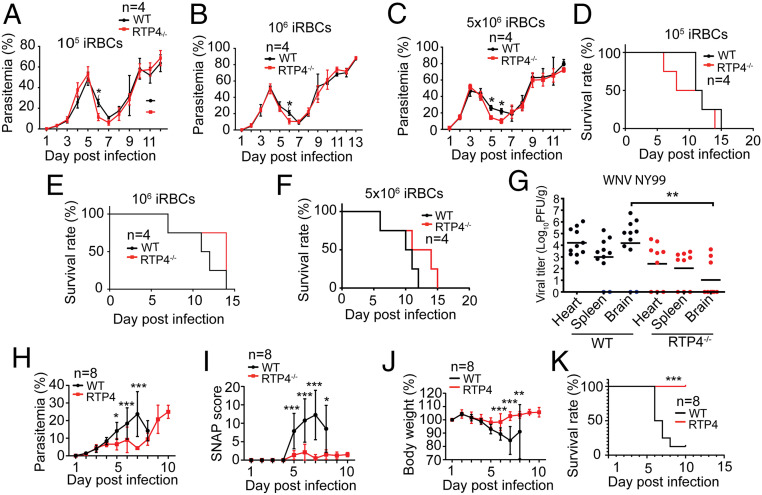Fig. 7.
Deficiency of RTP4 significantly decreases parasitemia, cerebral malarial symptoms, and viral load in the brain. WT and Rtp4−/− mice (n = 4) were injected i.v. with N67-infected red blood cells at three different dosages (1 × 105, 1 × 106, and 5 × 106). Parasitemia and host survival rates were monitored by counting daily thin blood smears and pain scores. (A–C) Dynamics of parasitemia after infection of WT and Rtp4−/− mice with different dosages of P. yoelii N67 iRBCs. (D–F) Host survival curves of the infections in A–C. Parasitemia was quantified using Giemsa-stained smears of blood samples using a microscope. (G) Viral titers in the heart, spleen, and brain at day 7 p.i. with 103 PFUs of WNV. Each dot represents an individual mouse, and the data are pooled from three independent experiments. (H) Dynamics of parasitemia after infection of WT and Rtp4−/− mice with P. berghei ANKA iRBCs (1 × 106). (I) SNAP scores of infected WT and Rtp4−/− mice. (J) Body weights of infected WT and Rtp4−/− mice. (K) Host survival rates after P. berghei ANKA infection. Note: Only one mouse remained in the WT mouse group after day 8, and measurements for WT were not done. For malaria infections, means and SD from replicates (n) are as indicated; for WNV infections, means of 9 to 14 mice per group are indicated. Two-way ANOVA (A–C and H–J), logrank (D–F and K) , and one-way ANOVA (G): *P < 0.05; **P < 0.01; ***P < 0.001. F test compared variances for H–J with F = 1.53 and DFn = 9. All experiments were independently repeated with similar results.

